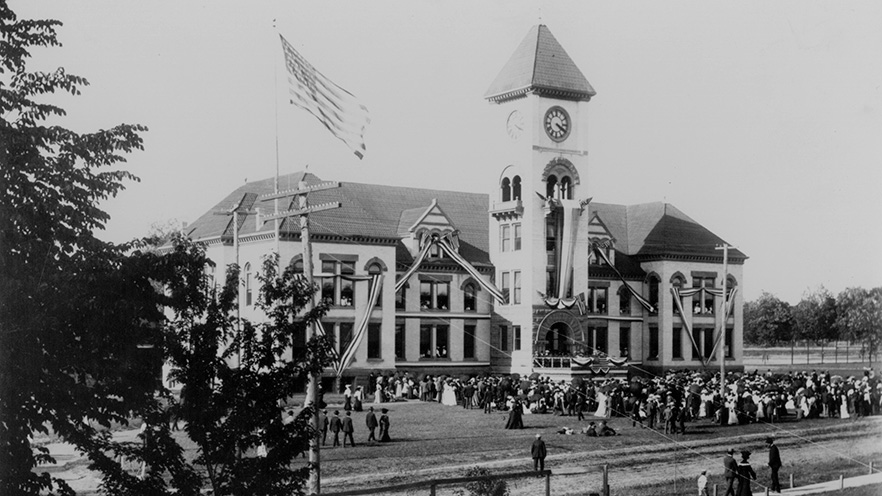Architectural History: New Minor Explores the Built Environment
Whitman’s newest minor investigates the interaction of people and the spaces we build
By Heidi Pitts ’01

Architectural history is on campus and in the classroom. In this circa 1903 photograph, a crowd gathers in front of Memorial Building. This centerpiece of Whitman’s campus was completed in 1899.

Matthew Reynolds
Architecture is more than just the design of buildings—it tells the story of societies, conceptions of art and political movements throughout time. From ancient temples to modern skyscrapers, the built environment shapes how people live, move and express cultural values.
Architectural analysis has long been a key component of Whitman’s Art History curriculum, encouraging students to think critically about how spaces influence human experience. Now, with the launch of the Architectural History minor in Fall 2025, that focus is being formally recognized.
“The Art History department continues to evolve with the times,” says Associate Professor of Art History Matthew Reynolds. “We’ve been teaching classes on architecture and modernism, or architecture in specific places like Los Angeles, for over a decade. This minor makes visible the work we’ve already been doing and gives students a clear path to pursue it further.”
Architecture as a Cultural Lens

Krista Gulbransen
At its core, the study of architecture at Whitman is deeply interdisciplinary, weaving together perspectives from a wide range of fields.
“In the Architectural History minor, students learn to think critically about the social, cultural, political, economic, environmental and technological factors that shape the built environment,” says Associate Professor of Art History Krista Gulbransen. “We ask questions like: Who were these spaces designed for—and who was excluded from them? How does a building’s aesthetics align with its intended function? How do materials and aesthetics align with power structures or systems of oppression? How can design be made more sustainable?”
Build Your Own Architectural Journey
The Architectural History minor will offer a flexible approach to studying the built environment. Students can choose from a variety of introductory courses before diving into Critical Art History (Art History 203). Advanced coursework will allow students to explore specialized topics from the Taj Mahal in India to the urban environment of downtown Los Angeles.
Students can also expect experiential learning opportunities that connect theory to real-world contexts. Activities may include walking tours of historic buildings in downtown Walla Walla, field trips to museums like Tamástslikt Cultural Institute and Maryhill Museum of Art, and site-specific research on local monuments and memorials. And with the option to incorporate related study abroad experiences or courses from other Whitman programs, students can shape the minor to fit their unique academic and career goals.
Research That Expands the Classroom
Whitman’s Art History faculty bring architectural history to life through global, justice-oriented research—and they’re eager to involve students every step of the way.
 Gulbransen’s current project examines the British colonial production of full-scale plaster cast replicas of Indian monuments, exploring how their display in European museums served imperial narratives. Reynolds’ work focuses on public art and environmental memory. His recent book, “Maya Lin, Public Art and the Confluence Project,” investigates how large-scale installations along the Columbia River confront climate change and settler colonialism.
Gulbransen’s current project examines the British colonial production of full-scale plaster cast replicas of Indian monuments, exploring how their display in European museums served imperial narratives. Reynolds’ work focuses on public art and environmental memory. His recent book, “Maya Lin, Public Art and the Confluence Project,” investigates how large-scale installations along the Columbia River confront climate change and settler colonialism.
Other faculty include Associate Professor of Art History and Paul Garrett Fellow Lisa Uddin and Senior Adjunct Assistant Professor of Art History and General Studies Libby Miller. Uddin directs Whitman’s Social Justice Concentration and studies the racial and spatial politics of built environments in the U.S. Miller’s interest in how humans coexist with history contributed to extensive research around the Marcus Whitman statue near campus in conjunction with the student-led Indigenous People’s Education and Culture Club.
Students often take part in faculty research. Gulbransen recently traveled to Berlin with a student to study replicas of Buddhist architectural gateways, and Miller, Reynolds and Uddin have led student-curated museum exhibitions and site-based investigations throughout the Pacific Northwest, connecting academic inquiry with real-life experience.
Inside the Classroom: From Utopian Ideals to Iconic Homes
One piece of architectural history that Associate Professor of Art History Matthew Reynolds loves teaching is the Case Study House Program in Los Angeles, which aimed to create affordable, well-designed, middle-class homes for the region’s booming post–World War II population.
For various reasons, those designs were never adopted at scale, and the prototypes became unique, precious and hyper-expensive homes. Still, the program allowed architects and designers to experiment with innovative ideas—open floor plans, integrated indoor-outdoor spaces, and environmentally sustainable materials and construction methods.
Reynolds says students enjoy exploring both the intentions and contradictions of the initiative. “They’re drawn to the contrast between the utopian goals of the program and how those homes ultimately became symbols of wealth and status,” he explains.
Shaping the Future of the Built World
From analyzing colonial-era monuments to examining contemporary housing initiatives, Whitman’s new Architectural History minor invites students to explore how the built world reflects and shapes our values, systems and futures.
“Any students who care about how places and built environments came to be the way they are today—and how architecture can contribute to a more just, sustainable world—will find something meaningful in this minor,” says Reynolds.
For students drawn to big questions and bold ideas, the Architectural History minor offers a new perspective for understanding the world—and reimagining what it could be.